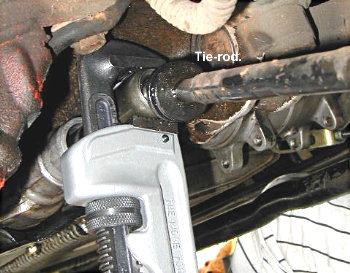Porsche 928 S4 Service
John Pirtle, May 7, 2003
http://members.rennlist.com/pirtle
Tie rods
A tie rod connects each end of the steering rack to the wheel hub. At
the wheel end of the tie rod is a ball joint, and the rack end has a
ball and socket. The usual problem is that the plastic socket liner wears,
permitting a loose fit - my car had 143,000 miles when I realized the problem. Over several weeks I had noticed the steering developed a tendency to
tramline during freeway lane changes, and over rough road I felt a knock
in the steering wheel. Finally the car became floaty, especially over
dips in the road and uneven surfaces.
To check the tie rods, jack each wheel. Grab the tire at the 9 and
3 o'clock positions and give a sharp tug in each direction. A clunk feel
would indicate a problem. With the car on jack stands, pull the rubber
boot back to uncover the ball and socket end. Feel for loose movement
while an assistance tugs on the tire.
(To check front wheel bearings, grab the tire at the 12 and 6 o'clock
positions. Push and pull to detect any movement.)
It is recommended to replace both tie rods at the same time, and also
to replace the rubber boots. An alignment will be necessary in order to
return the toe adjustment to specification.
Changing the tie rods is straight-forward, and the biggest challenge
may well be getting the new boots back in place.
- Remove the wheel.
- Remove the locknut on the tie rod ball joint.
- Often the tie rod end can be knocked out with a hammer. After
a couple of good whacks one of mine fell right out. I positioned
a crow bar on the tie rod to better position my hit.

- My other tie rod refused to budge so I used a generic tie rod
removal tool (my local auto parts store has a loan program). This
tool goes between the ball joint and the steering arm, and may damage
the ball joint (which is okay if you are replacing it).
My case also required a sledge hammer.

- The inside end of the tie rod can be unscrewed from the steering
rack with a pipe wrench.

- To help keep the alignment toe as correct as possible, I measured the old
tie rods and adjusted the new tie rods. My alignment tech later remarked that
the toe was pretty close!

- Place the rubber boots on the new tie rods. Check that the steering stop
donut is in place (mine had pulled off inside the old boots).
- New tie rods are quite stiff and getting sufficient clearance
was necessary to screw them into the rack. This was solved by having a
helper turn the steering wheel to draw the rack inward - be careful to
not turn too much!
- Maneuver the ball joint into place and secure the locknut. Torque
values (manual page 48-02) are:
tie rod to steering arm - 47 ftlb
tie rod to steering rack - 108 ftlb
- Position the boots in place. Some oil or WD-40 will help.
- Drive the car sufficiently to settle the suspension and have
a *correct* alignment. Please see
http://members.rennlist.com/captearlg/ for alignment information.
928 S4 Home







